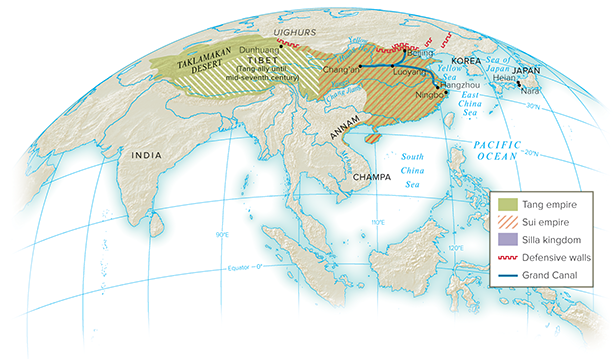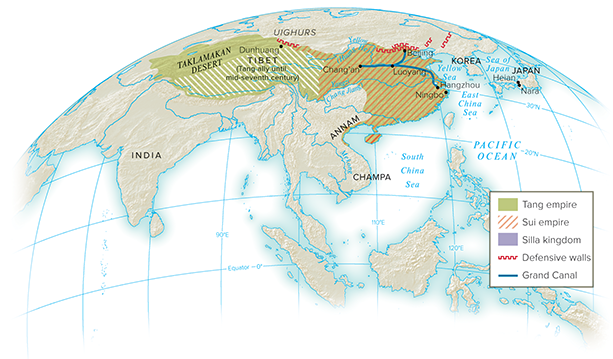(WIP) WHAP Unit 1.1 Developments in East Asia 1200-1450
1/13
Earn XP
Description and Tags
Region trade, which had been increasing since 600, paved the way for revived and new empires from 1200-1450.
Name | Mastery | Learn | Test | Matching | Spaced |
|---|
No study sessions yet.
14 Terms
Context: Sui Dynasty
- 581 - 618 Centralized gov. from Yang Jian’s military campaigns after centuries of turmoil
Grand Canal: 1k mile canal that connected agricultural South w/ North & cultural groups (most rivers run west-east)
618: Dependence on high taxes & forced labor & bad Korean military expeditions led to Sui Yangdi’s assassination

Context: Tang Dynasty
-618-907 Centralized under Tang Taizong who lowered taxes, banditry, & rice prices & expanded state to Taklamakan Desert
Extensive communication networks w/ resting spots, Middle Kingdom & rice
Chang’an: 2M
Equal-Field system: Equal & equitable distribution of land, but Buddhist monasteries & bribery & intimidation in 700s gave wealthy families large plots
Decline: Careless leaders = An Lushan’s 755 failed rebellion weakened Tang who compromised w/ Uighurs for strength
875-884: Huang Chao’s rebellion = increased regional military power & eventual takeover of China (Ruler abdicated)

Empress Wu Zhao
-690-706 Became a concubine of Tang Taizong at 13 y/o → Claims authority after successor & husband’s death, only empress in Chinese history
Secret police force & brutal punishments, military campaigns, & strengthened Civil Service Exam to squash rebellions & aristocratic forces
Patronized Buddhists
The Song Dynasty
-960-1279 China: Neo-Confucian Meritocracy w/ great wealth, stability, & artistic & intellectual adv., but mistrusted military
Government Developments in the Song Dynasty
-Small but prosperous Bureaucracy & Meritocracy (lost Taklamakan Desert & Tibet)
Imperial Bureaucracy: Org. of appointed officials that carry empire’s policies, since Qin Empire (221 BCE - 207 BCE)
Meritocracy: Officials obtain positions by demonstrating merit, since Han Dynasty (206 BCE -220 CE)
Emperor Taizu: expands lower class males’ opportunities for education to score well on Civil Service Exam (still underrep.)
Economic Developments of Song Dynasty
-Context: (Tang’s fast & caloric rice + Tang’s gunpowder & paper money = more trade & pop) + (Sui’s inexpensive Grand Canal = transport, culture, agri. ) = Song is most populous trading center
Agriculture: manure, irrigation (wheels, pumps, terraces), plows & beasts of burden
Champa Rice: Fast-ripening, drought-resistant, sometimes biseasonal rice from present-day Vietnam spread production to new areas = Cheap rice & extensive commercialized crops
Manufacturing: 1st guns, coal → coke = powered cast iron & steel production (reinforced ships & infrastructure/religious items/agri. tools)
Protoindustrialization: More rural goods than sales w/ gov. supervised, unpaid artisans & cottage industries
Most Commercialized Society: magnetic compass + paper + bigger ships “Junks” + navy = Shift to maritime in South China Sea w/ tea. porcelain, & textile exports
Hangzhou: 1M
Taxes: more $ circulation w/ gov. paying construction workers
Middle Kingdom: required tribute from surrounding kingdoms enforced thru Zheng He’s army & kowtow (bow to floor)
Porcelain
-Chinese perfected glazing techniques w/ extremely high kiln temperatures & kaolin clay from South; Korean & Japanese copies could not match
Lighter, thinner, & more adaptable to different uses than earlier pottery
Social Structures in China
-Mostly rural to most urbanized society w/ cosmopolitan metropolises Chang’an (ancient capital), Hangzhou (south of Grand Canal), Guangzhou (port city) w/ economic & entertainment centers
Hierarchy: Scholar gentry, aristocrats, farmers & artisans, merchants, indebted peasants & urban poor
Educated bureaucrats outnumbered wealthy heirs
Merchants = low class b/c no physical labor or creation
Illiteracy, gov. provided free healthcare for lowest class
Foot binding: Banned in 1912, done by young, high class girls to attract suitors, led to issues in health & public affairs
Religious Diversity in China
-Middle Kingdom disliked foreign influence of Buddhism, but Song Bureaucrats adopted & spread beliefs (Neo-Confucianism)
Zen/Chan Buddhism: Syncretic religion (+Daoism) that emphasized direct experiences rather than learning, remained popular among commoners even when Tang seized temples
Neo-Confucianism: 770-840 combined rational & abstract thought, spread Buddhism thru out East Asia w/ printing
-Theravada Buddhism: Personal enlightenment (Southeast Asia)
Mahayana: Mass enlightenment (China, Korea, Japan)
Vajrayana: Enlightenment thru chanting (Tibet)
Xuan Zheng
-629: Travel into Central Asia was banned China, but a Buddhist monk, appalled by the contradictions of Chinese Buddhist script, fled to South Asia for the purest sources
645-664: Return-death, popularized Buddhism in China by spending the rest of his life translating doctrines
Downfall of Song Dynasty
~900~1100 North conquered by seminomadic Khitan of Manchuria who recieved silk & silver tributes; 1100 nomadic Jurchen captures capital Kaifeng & North Song; 1279 Mongols take China
Overextended bureaucracy of high-wage officials = Unpowerful military = Waste of $
Japan
-1192: After Minamoto clan replaced Heian Court, they installed a shogun to rule
Feudalism: Daimyo’s power > Emperor & Shogun, hierarchy = little mobility w/ majority peasants
Japan suffered from regional rivalries until 1600’s centralized gov.
Bushido: Samurai upheld frugality, loyalty, martial arts, & honor unto death
-Separated from China by sea = more control w/ its interactions
Prince Shotoku Taishi (574-622) promoted Buddhism & Confucianism w/ Shinto & woodblock printing
Heian Period (794-1185) reflected Chinese culture in gov & art, first novel The Tale of Genshi
Korea
-Shared boundaries & adopted Chinese culture
Centralized gov. w/ educated Confucians & Buddhist peasants, adopted Chinese writing but had distinct language
Civil Service Exam: No social mobility
Vietnam
-Adapted Chinese writing & architecture but violently rebelled against China
Independent villages & merit-based bureaucracy of men that pledged allegiance to peasants & rebelled against oppressive gov.
Rebels shows strong guerilla warfare against weakening Tang
Nuclear family: Unlike Chinese extended families, women had more independence & rejected foot binding & polygyny